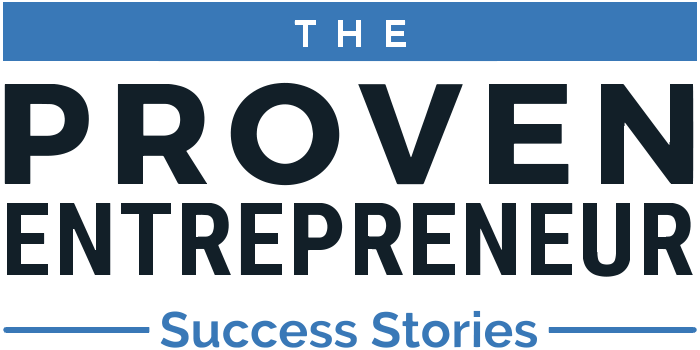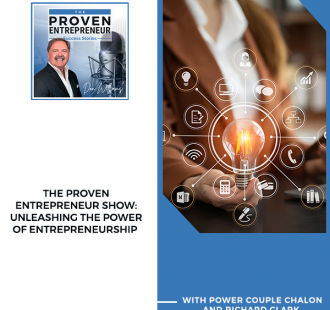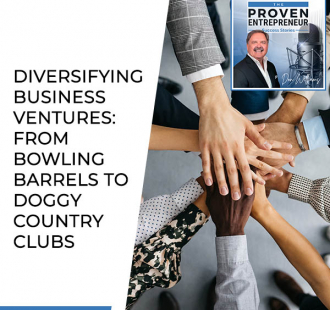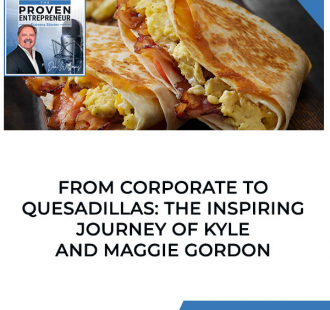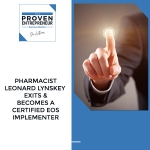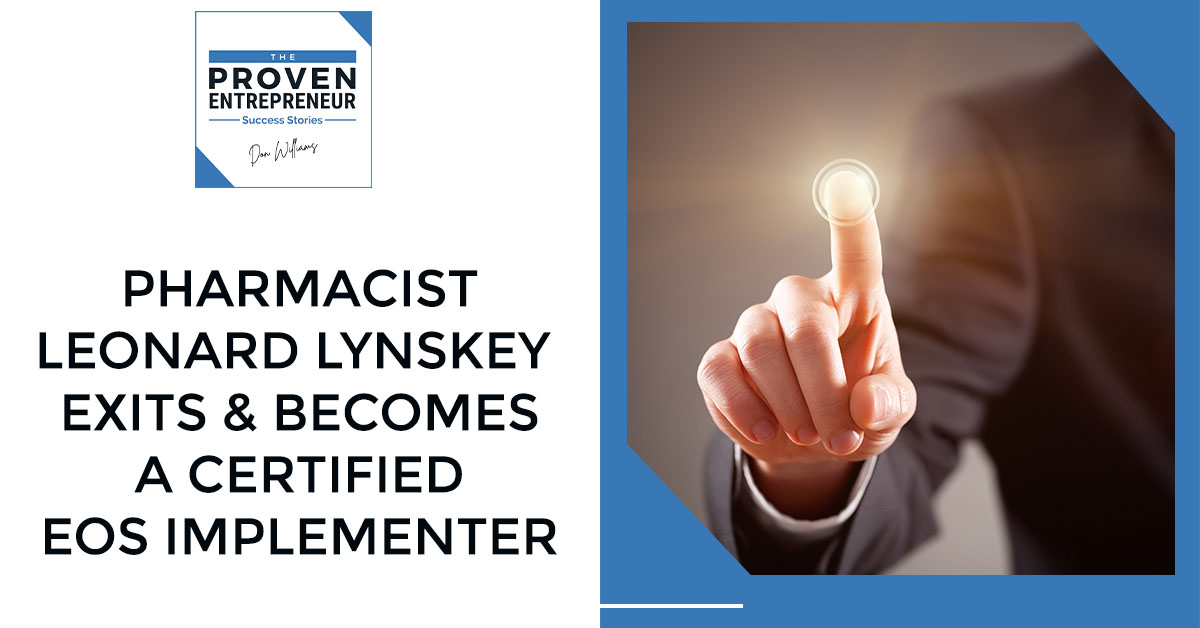
Need help with your business? Perhaps EOS is the solution you’ve been looking for! In this episode, Leonard Lynskey joins Don Williams to share how he went from being pharmacist to becoming a Certified EOS Implementer with his own company, Lynskey Management Services. Leonard knows very well the risks and potential downfalls of owning and managing a business. Tune in to learn about his transition and how EOS became the answer to his business woes.
For information on how to work with Don visit Work With Don Williams
You can also reach out to Don Williams at https://donwilliamsglobal.com
Please join Don and his businesses in support of St. Jude’s Children Research Hospital in its Mission to cure Childhood Cancers. You can donate to St. Jude at stjude.org/donate
—
Listen to the podcast here
Pharmacist Leonard Lynskey Exits & Becomes A Certified EOS Implementer
$2MM To $32MM & From Near Bankruptcy To An 8 Figure Exit
I got a good friend, a super entrepreneur, our guest. Welcome, Leonard Lynskey.
Thank you, Don. I’m happy to be here. I appreciate the invite.
I am thrilled to have you. I know a part of your story. I’ll give a little background here and then I’m going to toss the ball to you. Leonard is a recovering pharmacist and was a practicing pharmacist. You owned your pharmacy a couple of different times. We’ll get into that story a little bit. It’s a fascinating story. You are an EOS Implementer, helping entrepreneurs get control of their businesses and their lives. Let’s go way back to young Leonard. Childhood Leonard to 18, 20, what was your first job?
My first job was probably mowing yards with my dad. I could edge and trim the flower beds and he’d pay me $0.50. When I say edge, I’m not talking about a gas-powered weed eater. I had an edger with teeth that you pushed the edges and my flowerbed trimmer were scissors that you squeezed. It was a job for $0.50.
How old were you, Leonard?
I was probably eight.
At my first job, I mowed the yard, not because I got paid but because there were consequences if I didn’t mow the yard. I probably started about the same age. Were you raised in an entrepreneurial household? Were your mom and dad entrepreneurial?
Not at all. My parents grew up farmers. My parents were older when they had me, a product of the Depression. My need to work was born out of a need to earn. From the yards, I started delivering circulars for a local drug store in Lubbock. They’d pick us up in the afternoon and we’d put circulars in people’s mailboxes for a couple of hours a day. It was contract work. From there, I had a paper route. That’s when I got the entrepreneurial bug because I had about 60 customers, got another one and ended up with about 400 customers. I was making $300 to $400 a month when I was in 8th grade.
Keep throwing stuff against the wall until it works. Click To TweetTrying to dominate the newspaper market in Lubbock, Texas. Even before that entrepreneurial stint, it sounds to me like you start with a great work ethic.
That’s the one thing my parents gave me. If you wanted something, you had to go out and get it.
We’re up to 50 or 60 interviews. Many entrepreneurs did not have entrepreneurial parents or grandparents but they learned to work hard very early. Would you say the newspaper business was your first entrepreneurial gig?
The newspaper business was my first entrepreneurial gig because I bought products from a supplier. I managed a customer base. I had to do collections. I had to get work, do work and get paid. I managed all of that and it was totally on me. We moved to Dallas by then. I was throwing papers in Garland but I decided that I was going to mimic The Dallas Morning News guys. Rather than going door to door and doing monthly collections, I put envelopes in the paper.
What I failed to appreciate and that was driven home to me was that part of the charm of receiving The Garland Daily News was not the news but it was the kid throwing the newspaper. When I moved to systemize collections, I lost about 25% of my customers. I had given away the charm that was the local kid delivering papers. It was a very valuable lesson for me.
You were born and raised in Lubbock, moved to Garland and did the newspaper. Where did you go to school?
I went to school at the University of Houston. Along the way, I got a job at a drug store. I was selling cigarettes because they sold cigarettes in drug stores back in the day. One Sunday morning, none of the kids in the pharmacy showed up because it was the morning after prom. The pharmacist came up and said, “Can you type?” I said, “I can type.” He said, “You make $0.30 an hour or more in the pharmacy.” I moved to the pharmacy and fell in love with it.
The ability to be able to connect with people, have a conversation, recommend something for them over the counter, provide medications for them, the education, counseling and to help is my motivation. My why is to be able to teach and help, I fell in love with being a pharmacist and helping people one on one. That prompted me to go to pharmacy school. I went to the University of Houston and got a degree in Pharmacy. I graduated from college in 1985.

After you graduated from pharmacy school, did you immediately become an entrepreneur or did you take a job?
I took a couple of jobs in East Texas, false starts. Neither one of them lasted very long. I went to work for an absentee store owner in Rusk, Texas. That’s where I cut my teeth. The guy showed up twice a year. He gave me the keys to the store and said, “Make it work.” Over a 3 or 4-year period while I was there, I doubled the store with no insight and help, just good customer service.
My whole strategy is that as an entrepreneur, one of the keys to success is perseverance or, as I like to say, “I’m too stupid to fail.” You keep throwing stuff against the wall until it works. The experience that I got in Rusk was this hands-off owner who handed me his store and said, “I need you to make it work.” That’s what I did.
Entrepreneurs are, at their base, problem solvers. Not necessarily intelligent problem-solvers. Sometimes it’s like, “I tried this, that and then the other thing. Finally, I found the thing that solved the problem.” Too stupid to quit, so to speak. Years ago, you had a successful exit from the pharmacy business but also know that the path to that exit was fraught with problems. Tell us a little bit about that story.
All of my businesses have been family businesses. We started or bought and sold probably half a dozen pharmacies all of them successfully, except for one we had to close. The last one, we opened a little pharmacy in Sachse, Texas. When I say we, it’s my daughter, my wife and I. My wife’s usually always employee number one. As soon as I hire employee number 2, then employee number 1 retires.
We started this little pharmacy and limped along. It was always my dream to have a little corner drugstore like I’ve seen all my life in Rusk and Rowlett but the market had changed. It was passing it by. Managed care was moving in mail-order prescriptions. We were in Sachse. A lot of people there worked for the school system or in the telecommunication corridor. We built a book of business up, insurance would change, they’d all have to go to mail order and it dropped 50%.
A nurse walked in one day and said, “We’ve got these four clients that live in a halfway house. They’re intellectually and developmentally disabled. We need somebody to take care of them.” My background in a previous pharmacy that I’d had was we’d specialize in doing dialysis and transplant. This whole concept of niche pharmacy or specialty pharmacy, I was very familiar with. We were starving, so I said, “We’ll do it.”
I realized quickly that these four clients in this one halfway house were connected to a company that had 6 or 7 other houses in the Dallas area, which was connected to a company that had provided all over the state. There was this market where there were about 30,000 IDD clients that fit this particular niche that was underserviced. They were serviced by about 500 providers, so we saw an opportunity.
To be successful, you have to be the dumbest guy in the room. You needed to surround yourself with people that are smarter than you and could help figure out the best way forward, not just your way forward. Click To TweetThat was in 2005. It took a couple of years to figure out the story and how to service them and meet their needs well. In 2007, we took off. From 2007 to 2011, we grew from about $2 million in revenue to $32 million in revenue, which sounds awesome on the golf course or at a dinner party but the reality is that I’m a pharmacist by training. Although I had done a stint as Executive Vice President for CVS, I had never run a business. My answer to everything was you can grow out of it if I could get more revenue. Get more clients, spend more money and hire more people.
The problem was, on $32 million worth of revenue in 2011, we had a controller who had stolen $271,000 unbeknownst to us. We were executing so poorly that we had created competition where none of it existed. We were 50 days behind with my primary vendor. I was $7 million in debt. I didn’t know what to do but I was too stupid to fail. At the time, I was in Vistage, which is a CEO peer group. One of my buddies was in there and he said, “You need EOS.” I said, “What’s EOS.” He said, “It’s a how-to for people like you.”
People like me are visionaries. A lot of vision, not a lot of execution, not much on the day-to-day but I can see the big picture and hope I can get enough clients, spend enough money and hire enough people to make it work. That strategy kept getting worse, making it worse and worse. I can remember sitting in meetings going, “If we could get to $15 million, $20 million or $25 million, things will be better.” Things were never better. We started implementing EOS in August of 2012. By the end of 2013, we were breakeven from a cashflow standpoint. At the end of 2016, we had an eight-figure exit.
Tell us a little bit about EOS.
EOS is based on a book called Traction which was written by Gino Wickman. The idea behind EOS is that for every business, regardless of industry, there are six components that you have to strengthen. To the extent that you strengthen these components, you get control of your business and get a better life. All entrepreneurs start their businesses and they have this vision of what their entrepreneurial life is going to be like.
It usually involves raining money, laying on the beach, private jets and lots of time with your family. The reality of their life is they’re working 60, 70, 80 hours a week and powering through. The tools and disciplines in EOS give you the ability to create a business that is predictable and sustainable so that you can begin to marry your entrepreneurial vision with your entrepreneurial reality.
EOS stands for?
The Entrepreneurial Operating System.

How many companies in the US are using or have used EOS?
There are 14,000 companies running on EOS. When I talk about 14,000 companies running on EOS, these are companies that have hired an implementer like me to help them implement the system. EOS Worldwide thinks that for every 1 company that has an implementer, 10 more companies are self-implementing EOS in some form or fashion.
Tell us a little bit about your entrepreneurial journey as an EOS implementer.
We sold the pharmacy because once we got it under control and it started making money, we took a long-term look at where we thought healthcare was going to be 10 or 15 years down the road with all the changes that were coming, the Affordable Care Act, reimbursements, how much the cost of healthcare has gone up and where we thought the cost controls were going to be.
Ultimately, the decision that we came to was that a small regional player in Rowlett, Texas would eventually not have a seat at the table. Right or wrong, good or bad, that was our decision. We decided that once we exited, I wanted to do something else. For all of you who are considering exits, one of the best pieces of advice that I got over and over was you need to figure out what you’re going to do next. As an entrepreneur, being drunk on a beach is not a strategy. It works for a week and then you’re going to be itching to do something.
In my next steps, what I thought about was how powerful EOS had been in helping us create a business that was predictable and sustainable. More importantly, it gave me my life back and it allowed me to be present. I wasn’t sneaking into the bathroom on my kids’ birthdays and sending emails. We go on vacation and I would say, “You’re going to have to accept that from 9:00 AM to 12:00 PM, I work on family vacations.” By virtue of being able to manage my business, rather than my business managing me, I was able to have the life that I wanted. When I was thinking about my next steps, I thought, “What I am passionate about is helping other entrepreneurs find that same path.” That led me to EOS.
How many clients do you have?
I have 25.
There are whos out there that can help you figure out your hows. Lean into those whos. Click To TweetYou’ve been doing EOS implementation for how long?
For several years, when I started doing EOS, I went to bootcamp and got credentialed through EOS Worldwide. When I told my story and talked about EOS and how great it was, I thought entrepreneurs would be the path to my door. They did not.
Many entrepreneurs think, “If I opened my business and hang out my shingle, there’ll be an eternal line of customers.” Typically, that’s not the case.
How it worked in the pharmacy, it’s not how it worked with EOS. Probably, it’s not how it works in any business.
You got to get out there, shake hands, kiss babies, tell your story and tell it well.
I had to learn a whole new skillset to be able to do that, a skillset that I had never had before.
Think back to a hard lesson you’ve learned in your entrepreneurial journey that you’d share with us. Things were not good.
The hardest lesson that I ever had to learn was that I had to trust the people around me. As this business grew, before we started EOS, I thought I had to have all the answers. I kept doing the same things over and over, expecting a different result. Everybody knows that if you keep doing the same things over and over, it’s a definition of insanity or, as Henry Ford says, “If nothing changes, nothing changes.” One of the most difficult things I had to embrace was that I had to realize that for me to be successful, I had to be the dumbest guy in the room. I needed to surround myself with people that were smarter than me and could help figure out the best way forward, not my way forward.
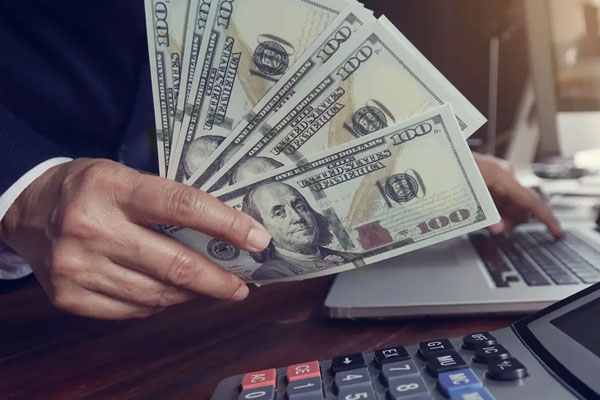
One of the things that EOS gave me is the way it systemizes executing your vision with discipline and accountability, it gives everybody a voice at the table and the courage and vulnerability to be able to trust your team because you’ll know that they’re going to deliver. The best example of that for me is on April 4th, 2016, we got a letter from Texas Medicaid that said as of May 1, 2016, we are changing how we reimburse for medications. With the stroke of a pin on May 1st, 2016, the great State of Texas sucked $1 million out of my bottom line. We were for sale. Imagine how that looks on a multiple.
Two years before we started EOS, we would have been running around the hair on fire like chickens with their head cut off, “What do we do?” There was still a lot of that. The reality is because of the systematic way in which we ran our business using EOS, we were able to sit down. One of the cool things that EOS does is it takes these big issues like COVID. “I can’t get sales. We lost $1 million because of forces outside of our control. What are we going to do?” What it allows teams to do is break these big issues down into their simplest forms. Issue by issue, week by week, quarter by quarter, you begin to solve them.
The solution wasn’t easy. We had to make some hard decisions. It took a few months but four months after we got that letter, we’d made up the entire $1 million. It was because we had a systematic way to approach issue solving and I knew that no matter how big the hill looked, I could rely on my team to find the best answers to move forward. That’s exactly what happened.
Tell us about a warp speed moment. Things are going pretty good in your business and then all of a sudden, 1, 2 or 3 things fall into place and it blossoms.
I always did sales in my companies. I’ve always done startups because, as a visionary, I have the attention span of a gnat. Once I start managing a business, I lose interest in it. We had this business we’d grown fast. We had these incredible issues that we had to solve because we were a hot mess. One of the areas that we were stuck in was how do we get more sales. My answer had always been, you go out to a client, sit down with them, throw up features and then pray that they say yes. If they say, no, I got nothing. The tank is empty. I don’t know what step two was. I do now but I didn’t then.
We had gathered up all the low-hanging fruit, all the people that were in so much pain, that I was the clear answer. We had stopped adding new clients. My answer was, “Sales is magic. If you go to the magic box, stuff a bunch of money in it and shake the box hard, sales will fall out.” We hired a salesperson. They came in. I handed them a phone and they said, “What do you need?” I said, “We need sales.”
A year later, I was their biggest client and I fired them because they were not getting sales. Being the bright guy that I am, I went back to the magic box. I put more money in the box, shook the box even harder and got a high-priced recruiter to go find a high-priced sales professional. If you throw more money at it, that’s the answer. Six months later, they quit because they could see the writing on the wall.
We’re using EOS and understanding the power of accountability, discipline and process. What we did was rather than throw money at the problem, we took a step back because sometimes you have to slow down to speed up. We hired a sales coach, identified our sales process, the necessary steps, who we needed to be talking to, who our target client and our targets within the clients. We created the sales process and got the right person in the seat who was an internal candidate. Magically, we got sales and took off. We didn’t get any new business to speak of for two years. We got the process nailed down and sent the person out there. In six months, we’d grown 25%.
You don't walk into a meeting with a potential client to sell them anything. If you'll walk in with the objective to help, great things will come of that and then the money will follow. Click To TweetWhat’s a word of wisdom from Leonard to the readers?
You don’t have to bear this burden alone. As an entrepreneur, in the back of your mind, you are always under pressure because, at the end of the day, you’re the guy or the gal that bears the burden of the business. You’re responsible for the culture, vision and resources. If this thing goes under, they’re not coming to get your employee’s hows. They’re coming to get your hows. That never goes away. That little pressure or voice in the back of your head is always there, which is why you work when you’re on vacation and you’re on your emails at 2:00 in the morning when you can’t sleep because they’re going to come to get your hows.
You’ve made a commitment to all the people that work for you that you’re going to make sure that they can take care of their hows. You do not have to do this alone. Read Who Not How by Dan Sullivan. There are whos out there that can help you figure out your hows. Lean into those whos. Find help and let people help you. There are plenty of people out there who will, if you’re clear on your vision, buy into your vision and will be just as dedicated to your vision as you are. Let those people help you. You are not alone.
If you could go back, we’ll put you in a time machine and you had 5 minutes with 20-year-old Leonard. In those five minutes, all you could do was share one piece of advice. What’s the one thing you’d tell your twenty-year-old self that would have sped you along your path?
Talk less and listen more. One of the things we teach in EOS and it’s not a concept unique to EOS, it’s a universal concept, when you’re talking to an employee, you should only talk 20% of the time. The 20% of the time you talk, you should be asking questions. Get better at asking questions and listening because there is a difference between hearing and listening. Listening is a full-contact sport. Hearing is letting things run through your ears. If I could tell my twenty-year-old self to shut up and listen, my journey would have been much less painful.
I love the questions versus statements. With my sales consulting clients, I’m like, “You can be a good educator with statements but questions sell, statements tell.”
One of the things I’ve learned as a coach is that it’s not my goal to sell. It’s my goal to help if some business comes out of some chemistry that develops and they think that I can help them solve a problem, one of the things that I had to learn was you don’t walk into a meeting with a potential client to sell them anything. If you’ll walk in with the objective to help, great things will come of that and then the money will follow.
If there’s one thing we could do for you as a client, what would you ask for yourself? It’s generally the hardest one I ask because entrepreneurs have a hard time asking for themselves.

I don’t know that I’d ask for anything. I’ve had an incredible journey. It’s been amazing. I’ve come from humble beginnings. Against all odds, I started several businesses, all of which were successful, even the ones that failed. In my mid-50s, I changed careers and have successfully made that transition in my mind. If I had one ask, I think the one ask would be I would like to have everyone who has had any input, influence or help that is provided help to me along the way. If I could get them all in a room to thank them, that would be my ask.
How would we reach out to you and find you?
You can call me, my cell is (214) 668-7761. You can find me on LinkedIn or reach out to my website at LynskeyManagement.com. I’m always happy to have a conversation or a cup of coffee and share whatever insights or information I might have.
Leonard’s a great friend. Reach out to him. It will be worth your time, I assure you. Leonard, thank you so much.
Thanks for having me, Don.
That’s it for this episode. See you next time.
Important Links
- Leonard Lynskey
- Traction
- EOS Worldwide
- Who Not How
- LinkedIn – Leonard Lynskey
About Leonard Lynskey
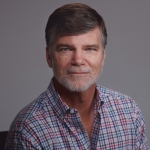 Leonard Lynskey became an EOS Implementer™ because of the profound impact EOS® had on his own company, helping him turn a failing multi-million dollar pharmacy business into an extraordinary success. Before EOS®, Leonard experienced his own share of sleepless nights trying to find his way past several significant hurdles. As his company edged closer to bankruptcy, concerns such as customer service, turnover, and of course cash flow were constantly occupying his mind. That left little room for the other important thoughts and activities that helped him keep balance, such as family time and vacation.
Leonard Lynskey became an EOS Implementer™ because of the profound impact EOS® had on his own company, helping him turn a failing multi-million dollar pharmacy business into an extraordinary success. Before EOS®, Leonard experienced his own share of sleepless nights trying to find his way past several significant hurdles. As his company edged closer to bankruptcy, concerns such as customer service, turnover, and of course cash flow were constantly occupying his mind. That left little room for the other important thoughts and activities that helped him keep balance, such as family time and vacation.
In 2012, he came across an EOS Implementer and soon after began implementing the EOS model in his business. In the span of two years, Leonard Lynskey and his leadership team turned the company around from a $2,000,000 loss to over $1,000,000 in profit, all thanks to EOS. After several years spent mastering the system for his own company, as well as coaching fellow business owners through their respective frustrations, Leonard realized his true calling was to help entrepreneurs with their journey through business counselling and EOS. Since becoming a Certified EOS Implementer and business process consultant, he has successfully helped many clients get more of what they want from their businesses.
EOS can be transformative for any business in any industry. Leonard will help you and your leadership team strengthen the six key components, correctly utilize the 20 tools, and implement a proven process that will allow your people to execute flawlessly. As a result, you will experience an immediate improvement in both your business and personal life. Connect with Leonard Lynskey today to schedule your introductory phone call!
For information on how to work with Don visit Work With Don Williams
You can also reach out to Don Williams at https://donwilliamsglobal.com
Please join Don and his businesses in support of St. Jude’s Children Research Hospital in its Mission to cure Childhood Cancers. You can donate to St. Jude at stjude.org/donate
